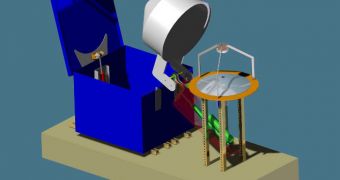Scientists operating the Cerro Tololo Inter-American Observatory are trembling with excitement. Next year, they are scheduled to receive one of the most sensitive cameras ever built, called the DECam, or the DES camera. It was developed by the Fermi National Accelerator Laboratory (Fermilab), in Batavia, Illinois, and it has the ability to peer deep within the Universe, and is widely considered to be the largest digital camera ever built. However, its operations depend on the smaller, but equally-important Radiometric All Sky Infrared Camera, or RASICAM, PhysOrg reports.
The second camera, which was designed and built by experts at the US Department of Energy's (DOE) SLAC National Accelerator Laboratory, is arguably just as important to the observatory as its larger counterpart. It is what astronomers refer to as a “seeing camera,” which means that its job is to look a little closer to Earth, while maintaining constant communications with its larger cousin. “DECam dwarfs RASICAM. But RASICAM plays an important role in DES observations. By instantaneously mapping high cloud distributions and contrails of airplanes at night, RASICAM will tell DECam if the atmospheric conditions in a particular direction are suitable for observing. Astronomers refer to this as ‘seeing',” explains Rafe Schindler, who is a professor at SLAC. The laboratory is operated by experts at the Stanford University.
The Cerro Tololo telescopes are located no less than 2,200 meters above sea level, atop a mountain peak in the Chilean Andes. By 2011, it needs to become able to search for dark matter throughout the Universe. This form of energy is believed to be behind the ever-accelerating expansion of the Cosmos, and also to account for about 74 percent of everything within it. However, since the idea that it exists was first hypothesized, no research group around the world has been able to identify it. This particular observations spot, which benefits from a beautiful view of the night sky, will receive advanced optics equipment, highly-sensitive cameras, as well as state-of-the-art data-acquisition systems.
But in order for all these systems to work flawlessly, the systems need to be told what is going on outside. And this is precisely where the RASICAM comes in. It will spend its time scanning the night sky for high-altitude cirrus clouds and airplane contrails, which may drift into the field-of-view of the primary camera. “These are a major irritant for astronomers,” explains Howard Rogers, a SLAC associate engineer whose job is to oversee the mechanical design, fabrication and installation of the infrared camera on the observatory.

 14 DAY TRIAL //
14 DAY TRIAL //